new posts in all blogs
Viewing: Blog Posts Tagged with: Trip City, Most Recent at Top [Help]
Results 1 - 4 of 4
How to use this Page
You are viewing the most recent posts tagged with the words: Trip City in the JacketFlap blog reader. What is a tag? Think of a tag as a keyword or category label. Tags can both help you find posts on JacketFlap.com as well as provide an easy way for you to "remember" and classify posts for later recall. Try adding a tag yourself by clicking "Add a tag" below a post's header. Scroll down through the list of Recent Posts in the left column and click on a post title that sounds interesting. You can view all posts from a specific blog by clicking the Blog name in the right column, or you can click a 'More Posts from this Blog' link in any individual post.

By:
Heidi MacDonald,
on 3/27/2013
Blog:
PW -The Beat
(
Login to Add to MyJacketFlap)
JacketFlap tags:
stand-up comedy,
Angry Bob,
Jeffrey Burandt,
Trip City,
Two Beards One Heart,
Billy Dogma,
Americans UK,
Awful George,
Jef UK,
Katharine Heller,
Meghan Turbitt,
Molly Knefel,
Night Job,
Rev Jen's Anti-Slam,
Reverend Jen,
Street Code,
Tommy Rocket,
Union Hall,
webcomix,
News,
Music,
Comics,
Comix,
politics,
Comedy,
Brooklyn,
Dean Haspiel,
indie music,
Indie Comics,
Digital Comics,
Top News,
Add a tag
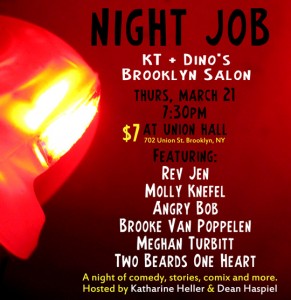
On March 21st 2013 at the Union Hall bar, restaurant, and music venue in Park Slope, Brooklyn, comics creator and TRIP CITY co-curator Dean Haspiel and comedian/actress Katharine Heller launched what may be the first of several salon events featuring comics, comedy, prose, and musical performances entitled “NIGHT JOB”. Though it was a new venture, neither Haspiel nor Heller are strangers to the stage. They were joined by stand-up comedian and writer Molly Knefel of the internet radio show RADIO DISPATCH, indie cartoonist Meghan Turbitt, author Reverend Jen of the long-running “Rev Jen’s Anti-Slam” performance event. Also performing were political satirist and stand-up comedian Angry Bob, and the music group Two Beards One Heart, including Jeffrey Burandt (aka Jef UK of Americans UK), and Peter Boiko, supported by John Mathias and John Thomas Robinette III.
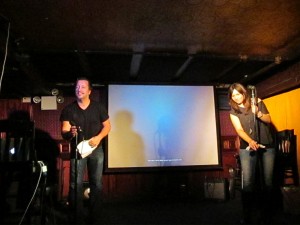
[Haspiel and Heller host the salon]
Though the salon opened to a full basement venue, audience members probably didn’t know quite what to expect from NIGHT JOB, however they might have known some of the performers by reputation. The term “salon” often implies multiple genres in the mix, and NIGHT JOB presented quite a range. Though each of these types of performance have the potential to be very entertaining on their own, it’s a challenge to combine them and create a sense of a cohesive event that, collectively, develops its own personality. NIGHT JOB found its way by emphasizing the raw power of very personal content from its salon members.
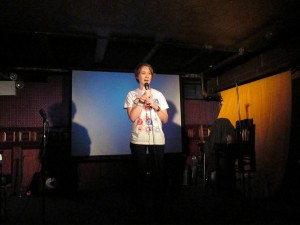
[Molly Knefel]
Knefel opened with a stand-up routine spoofing the “war on women” in congress last autumn, pointing out that a “war on anuses” would have had even the most conservative public official scrambling to sign up in protest. Her rapid-fire delivery and observational humor had the audience engaged from the outset, but her sense of personal commitment to the subject matter as a thinking person translating impressions of a bizarre world set the tone for the evening.

[Katharine Heller]
Heller read a selection from her recent project featuring “erotica” geared toward Republican sensibilities, “Tickle the Elephant”, and ingenious attempt to get inside the minds of what appeals to conservative women particularly. Turning the lingo of the senate floor and government catchphrases into turn-ons relentlessly, Heller narrated from the perspective of a conservative seduced by liberalism into a sexual common ground. Heller revealed a rather in-depth knowledge of politics on both sides of the party schism in her artistry, and in her mix of satire and humor, suggested dialogue is possible even in the most heated debates.
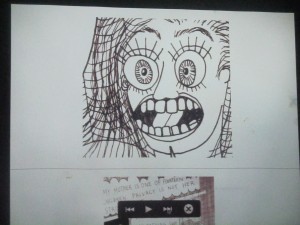
[A Turbitt comic panel]
Turbitt presented and performed a wide range of indie comix that appear online, increasingly irreverent to social taboos, particular in expressing women’s lives. From bathroom scenes of an intimate nature to things that most people find adorable but only annoy her, she pushed the envelope on expression and used the comic-panel reveal for shock-value. Her autobio approach struck many of the same chords as Knefel and Heller’s performances, bringing out the sense that discussing deeply personal subjects is still one of the most direct ways to reach an audience, who may be surprised to find out how much they have in common with the stories they hear and see.
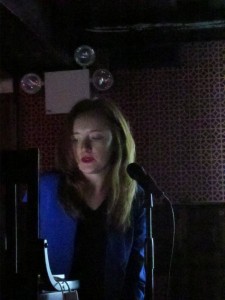
[Meghan Turbitt]
Haspiel’s comix performance of “Awful George” from his series STREET CODE took the audience deep inside the strangeness, and the horror of urban stories, reflecting his own autobiographical reaction to witnessing a make-shift attempt to save a hoard of cats that had been wilfully neglected in an apartment, only to be topped by the discovery of a mummified corpse, begging the question, “How do you deal with these kind of realities?”
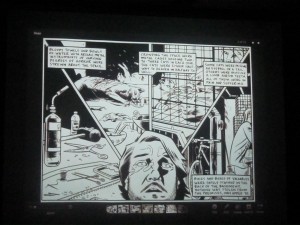
["Awful George" panel by Haspiel]
The answer from Haspiel is clearly “by expressing them and reaching out to readers”. His debut performance of a newly created Tommy Rocket comic, a spin-off from his BILLY DOGMA web comix, spoke to the twisted aspects of love, and the realities of failure and regret. Haspiel never pulls any punches in his comics, autobio or not, and these hammered home the role of authenticity in performance; getting up in front of a crowd to read your comics demands a kind of soul-baring stance that hits home for the audience.

[Dean Haspiel]
Reverend Jen took soul baring to a whole new level by reading from her unpublished novel, memoirs of her life as a prostitute attempting to support her artistic endeavors as a painter. She’s known for her extreme honesty during readings, and her narrative plumbed the depths of tragedy and suffering possible in what seems like an everyday world. Her description of images, as well as emotions, made for a stellar performance of prose. Rev Jen’s motivation in performing, to “get stuff out” of oneself actually also served the function of engaging the audience emotionally and reminding them, perhaps, of human resilience along the way.

[Rev Jen]
Angry Bob, true to his moniker, took on the role of voicing, like Knefel, Heller, and Turbitt, many of the things that people think, but don’t say out loud for fear of being ostracized as freakish. The truth, of course, is that they are not alone and everyone is wonder what’s considered “acceptable” to think or say in social settings. He described himself as someone “rooting through the garbage for shiny objects” like a racoon or other scavenger, and the objects he held up for inspection at NIGHT JOB were the ludicrous aspects of Reality TV, the curse of failed opportunities, and the general rage-inducing capabilities of young children, particularly in public. Angry Bob’s signature delivery, a high-octane rant that frequently addresses audience members directly, had their equally signature outcome: inspiring absolute hilarity at NIGHT JOB.

[Angry Bob]
The evening’s performances closed with the strikingly independent tones of Two Beards One Heart which also managed to match the ambiance of the previous salon members’ presentations. Not just in musical composition, whose sounds were so original as to suggest that the “personal” can be evoked as equally in sound as in words and images, but also in lyrics, Two Beards managed to create their own singular message.
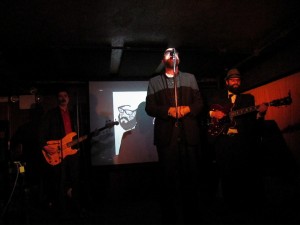
[Two Beards One Heart]
Their first song illustrated rising angst through lyrics despite its melodic construction, while the second contrasted the poetic, upbeat aspects of love with bigger realities and banal conflicts. Burandt’s vocals, far from predictable, were particularly engaging, and contributed to a sense of individualistic expression of life’s perplexing highs and lows.

[Jeffrey Burandt]
One of the most winning aspects of NIGHT JOB, aside from his cohesion as a salon of the personal made public, was the fact that Haspiel asked, repeatedly, if anyone else would like to perform their work, friend or stranger alike. It suggested an open-door to artists of any genre who also had something to share. The tone of the evening, celebrating unique perspectives with communal implications, was as well suited to comics as music and comedy.

[Haspiel delivers an open invitation]
Setting comics alongside other genres in performance is not a new practice, but it’s becoming increasingly popular, perhaps because of the rise of self-publishing and internet sharing of creative work. As comics find their footing among other artistic modes, it’s appropriate to start asking what comics have in common with other formats of expression, and what makes them particularly powerful for self-expression. NIGHT JOB did an excellent job of illustrating the point. Performance art forms are about a meeting of minds between the performer and the audience, and many genres already push the boundaries of inter-personal communication, comics included.

Hannah Means-Shannon writes and blogs about comics for TRIP CITY and Sequart.org and is currently working on books about Neil Gaiman and Alan Moore for Sequart. She is @hannahmenzies on Twitter and hannahmenziesblog on WordPress.

By:
Heidi MacDonald,
on 3/22/2013
Blog:
PW -The Beat
(
Login to Add to MyJacketFlap)
JacketFlap tags:
Blade Runner,
Jim Steranko,
Dean Haspiel,
Jonathan Ames,
Indie Comics,
Jimmy Palmiotti,
Top News,
Chris Miskiewicz,
leaping tall buildings,
seth kushner,
asbury park comic con,
Trip City,
Christopher Irving,
Creator Owned Heroes,
CulturePOP Photocomix,
Forcefield Fotocomix,
Stoya,
Zoe Sloan,
News,
Reviews,
Comics,
Add a tag
Photocomix are strange creatures. They look like a hybrid of a photography medium and a comics format, and when you spot them in the wild you’re never sure whether they arose as some part of a natural evolutionary process in art or if they were the result of some kind of misguided experiment, maybe even one gone wrong. That reaction’s been shaped by encountering low-quality work with vague pretensions at humor, or perhaps offering some behind the scenes reveals about the comics making process. Frozen, melodramatic poses and cheesy dialogue are par for the course. And so, if a reader spots photocomix roaming free online or in a shop, they approach with caution and refuse to get their hopes up regarding quality.
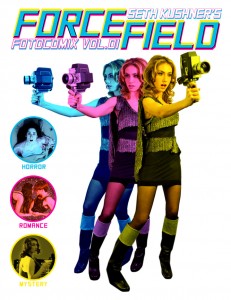
Then there’s FORCEFIELD FOTOCOMIX, which makes you feel guilty for all of that instinctual caution and pre-emptive wariness. It gives you what no one really dares expect or demand from photocomix, a team of seriously talented individuals on a mission to exploit the full potential of the medium. To do this, they decide to spin this collection of comics into a number of genres, covering all the bases and it’s as if they are illustrating future directions for photocomix.
The man behind the camera, someone whose work has defined “serious” photography of the cultural zeitgeist in the past decade and then some, is Seth Kushner, the co-creator of the celebration of comics tradition LEAPING TALL BUILDINGS with Christopher Irving. Kushner’s photo portraits of comics creators in LEAPING TALL BUILDINGS have garnered so much attention that they’ve been scavenged by internet sites repeatedly and Neil Gaiman even chose to use Kushner’s portrait of him as his new dust-jacket image. He’s been working on photocomix for some time now, creating a CulturePOP series for the digital arts salon TRIP CITY, profiling real lives in comics format from author Jonathan Ames to adult film star Stoya, but FORCEFIELD is a departure into the realm of total composition in fictional realities.
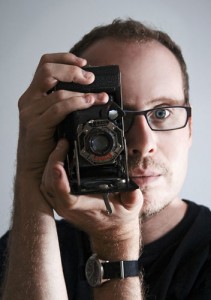
During an informal conversation at Hang Dai Studios, where Kushner keeps a tidy computer work station flanked by a few vinyl and action figures, he revealed some of the process behind his striking cover to FORCE FIELD. He staged a full-on photo-shoot to capture the images in his mind by engaging actress Zoe Sloan, as well as a costume designer and a makeup artist, to create a Barbarella homage fused with a direct design reference to a Jim Steranko cover of BLADE RUNNER from Marvel Comics. The Steranko cover, which uses multiple color reduplications of the hero pointing a gun, inspired Kushner to pose Sloan holding, instead, a Super 8 camera in retro style. The metaphor’s impressive: Kushner’s camera is a loaded weapon at the center of the strange narratives contained in FORCEFIELD, capable of directing the reader’s experience, and by using a Super 8 video camera rather than simply a camera, he’s suggesting the role of storytelling.
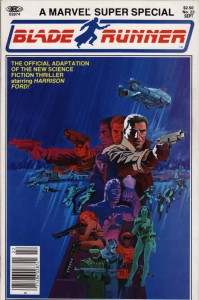
Kushner’s increasingly open these days to revealing the process behind his work to generate enthusiasm for the forms themselves and encourage others to experiment, as evinced by his recent contribution to TRIP CITY, a blow-by-blow narrative of the steps by which the first comic in the collection, “The Hall of Just Us”, called “Anatomy of a Photocomic”. The story, co-scripted by Emmy Award winning artist Dean Haspiel, led to its own formal photoshoot at the recently hurricane decimated by increasingly resilient Sunny’s Bar in Red Hook. Kushner and Haspiel set about “casting the roles, as we would for a film”, says Kushner, and the co-creators drafted full layouts for the comic before shooting, giving them a “map to follow”.
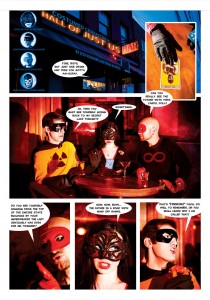
They created the comic shot for shot, a tale of three “miscreants”, superheroes in a bar chasing a super-powered lady’s attentions, “The Tarot”. After the shoot, time-consuming photo-shopping and comics construction added text, word balloons, and special effects. But all of this description only hints at the visual impact of “The Hall of Just Us”. It’s all about mood, created from strongly color-themed lighting (the pink, blue, and yellow of the cover’s design), and about the off-beat simple hero costumes straight off of Mego action figures or the BATMAN television show of the ‘60’s.
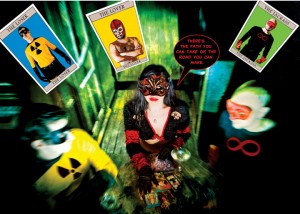
While the heroes posture and ratchet up the bombast, The Tarot figure, portrayed by model and artist Katelan Foisy, brings an eerie presence and substance to the narrative. She can see the future “sometimes” and sees the other heroes as Tarot figures, commenting “There’s the path you can take or the road you can make”, but she’s really calmly waiting for her “date” known as Señor Amore, portrayed by Haspiel. This is certainly the “romance” genre promised by the cover as one narrative alternative, but it leaves room for reader-interpretation. Superheroes with super powers are still hanging out in a bar, looking for love, for one thing.

“Spiders Everywhere” provides the “horror” also promised by the cover, and again homage to genre comics and films is evident. The narrative and premises are simple- horrific waves of spiders taking over the world, but Kushner plays to the strengths of the photocomix medium by conveying frantic movements and moments of psychological realization in cinematic style.
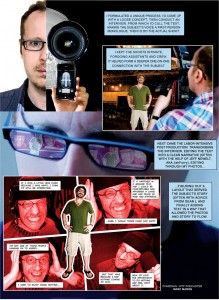
“Understanding Photocomix”, a visual walk through Kushner’s history with photography and photocomix, which first appeared in American Photo Magazine, supplies the metadata on the very form in which its composed. It also forms a clever narrative bridge between the first chapters of FORCEFIELD and its follow up chapter COMPLEX, by explaining Kushner’s increasing drive to push the boundaries of photocomix in a “full fictionalized graphic novel” that he’d “direct like a movie using actors and locations”. In many ways, FORCEFIELD is the herald of that process, and it’s Volume number “.01” suggests that it’s a forerunner of bigger things to come.

The story COMPLEX: “Luv_Underscores_U”, kicking off Kushner’s work on his dream project of the COMPLEX graphic novel, first appeared in Jimmy Palmiotti’s CREATOR OWNED HEROES #7 alongside Kushner and Irving’s ongoing profiles of indie comics creators (a follow-up project to LEAPING TALL BUILDINGS). It’s a lavishly shot and designed comic which plunges into science-fiction BLADE RUNNER style, another link to FORCEFIELD’s cover image. It constructs multiple virtual realities visually with ethereal attention to detail and emphasizes a governing psychological perspective, a central character keeping all these virtual worlds in motion for the reader. This isn’t far from the role of the camera itself seeming to direct the reader, perhaps FORCEFIELD’s hypothetical Super 8 on the cover itself.
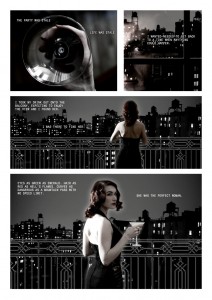
The final chapter of FORCEFIELD, a never before published noir tale, “The Perfect Woman” appears in uncharacteristic emphasis on black and white tones, with hints of color. Kushner’s photography is known for its psychedelic presentation of color through light effects, but also for his more sepulchral, moody hues in portraiture. Here he does with black what he often does with a solid color, making it a rich compositional basis into which he incises featured characters and settings. Like a compelling dime store novel rich with noir tropes, the story pursues an elusive lady in a cityscape from the visual perspective of a narrator. Kushner’s locations for this shoot were clearly exacting, capturing a city of the 1930’s complete with architectural detail. But the reader should have expected that this is a collection of stories with an expicit BLADE RUNNER homage and technology and perception may play as strong a role as the romance of pursuit.This is the “mystery” genre, completing the triad of color themes and pulp homage.

To add to the total design package that is FORCEFIELD FOTOCOMIX, it’s also presented in slick prestige magazine format with card covers, suggesting that photocomix can find their own effective dimensions for publication, in this case somewhere between a traditional comic and a traditional large-format photobook. But the format also speaks to Kushner’s consistent, passionate attention to detail throughout the collection which seems to constantly remind the reader of his fundamental belief in the art behind the form. The photocomix in FORCEFIELD are visually riveting, one might even say mind-altering, but the stories are also expansive, creating strange pocket universes with their own sets of rules and assumptions. Exploring them is part of the intrigue. Seeing FORCEFIELD in the wild is bound to make an impact on our assumptions about what photocomix have been, and more importantly, what they can be as a narrative medium in their own right. Kushner was inspired by comics, photography, and films to launch this project. In the future, creators might well be saying that they were inspired by FORCEFIELD to take photocomix in equally surprising and mesmerizing directions.

[Kushner answers, "What's the coolest item in your collection?" for Hanzarai.com]
FORCEFIELD FOTOCOMIX Vol.01 will be available for physical sale for the first time at the upcoming Asbury Park Comic Con March 30th, but the limited edition is already available for order through Kushner’s etsy shop.
Title: Seth Kushner’s FORCEFIELD FOTOCOMIX Vol.01/Publisher: Self-Published/Creative Team: Photographer, Seth Kushner/ Design, Seth Kushner and Dean Haspiel/ Writers, Seth Kushner, Dean Haspiel, Chris Miskiewicz/ Edits by Dean Haspiel
Hannah Means-Shannon writes and blogs about comics for TRIP CITY and Sequart.org and is currently working on books about Neil Gaiman and Alan Moore for Sequart. She is @hannahmenzies on Twitter and hannahmenziesblog on WordPress.

By:
Heidi MacDonald,
on 3/6/2013
Blog:
PW -The Beat
(
Login to Add to MyJacketFlap)
JacketFlap tags:
News,
Events,
Indies,
Webcomics,
Dean Haspiel,
Tails,
Image Comics,
Laura Lee Gulledge,
Page by Paige,
Top News,
Trip City,
Christopher Irving,
ACTIVATEcomix,
Autobiographical Comics,
Billy Dogma,
Bob Fingerman,
Ethan Young,
Housing Works,
Maximum Minimum Wage,
Streetcode,
Will and Whit,
Comics,
Benefits,
Image,
Add a tag
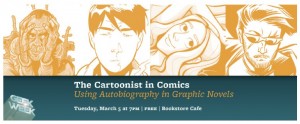
Autobiographical comics used to be a feature of zines and small private presses, but readers are increasingly able to follow their favorite genre of the comics medium in graphic novel editions from mainstream book publishers. There’s no doubt that the artistic appreciation for autobiography and semi-autobiographical works is on the rise, but amid commentary on layouts, designs, and narrative choices, it’s easy to lose touch with the personalities behind the works and the often difficult waters they navigate to create their comics. At Housing Works Bookstore and Café in Soho, part of the Housing Works charitable organization benefitting those affected by HIV/AIDS and homelessness, four cartoonists weighed in on their life in comics on March 5th in a panel hosted by comics scholar and author Christopher Irving (LEAPING TALL BUILDINGS, GraphicNYC). The event formed part of “Geek Week” at Housing Works, with copies of speakers’ books donated by publishers for sale to support the charitable organization.
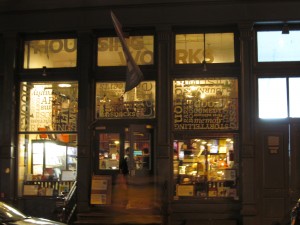
Panelists included Dean Haspiel (BILLY DOGMA, CUBA: MY REVOLUTION), Bob Fingerman (MAXIMUM MINIMUM WAGE, FROM THE ASHES), Laura Lee Gulledge (PAGE BY PAIGE, WILL AND WHIT), and Ethan Young (TAILS) and featured projected slides of their artwork along with readings, commentary, and discussion. Haspiel read “Dumbo” from his STREETCODE series, a tale of extensive personal injury after being “busted” as a thief by an overzealous and perplexed local driver during a film-shoot in Brooklyn and Fingerman read from an unpublished script of issue #11 of his acclaimed MAXIMUM MINIMUM WAGE series (which will appear in the new deluxe edition coming from Image March 20th) about the trials and tribulations of negative reviews and the dubious creative credits of working for “porno mags”. Gulledge, too, presented previously unseen material from her upcoming (in March) new book WILL and WHIT dealing with the stresses and awkwardness of teen life pursuing artistic expression, while Young read from his series TAILS, featuring cultural and familial clashes over relationships, but also noted that a second printed volume of the previously online series TAILS will be coming soon from Hermes Press.

Each of the cartoonists presenting their work engaged the audience on an emotional level in different ways, showcasing the versatility that makes autobiographical comics so popular. Haspiel’s comic narrated the already inherently absurd scenario of playing a thug in a friend’s film being chased by a costumed superhero an the equally absurd but downright serious impact of being mistaken for a real thief and being mown down by a would-be vigilante on set. Haspiel’s “DUMBO” focused on the psychological shock and mental processes handling the bizarre, and all too physically real situation.

Fingerman’s script handled his experiences working for a “rag” magazine in semi-autobiographical fashion through his avatar “Rob”, with an ear for frank and surprising dialogue between Rob and former co-workers on the subject of a bad review of his comics issued by a replacement writer in Rob’s own former column on the magazine. Through Rob’s dialogue, the audience could hear the character’s increasing fixation and personal struggle with the affront, while other characters commented irreverently on his overblown reactions. The emotions of the situation were powerful, even while comedic in tone.
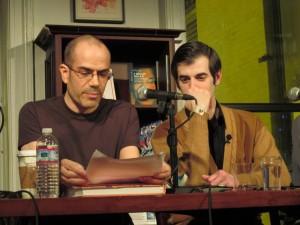
Gulledge’s selection from WILL and WHIT used limited but realistic dialogue between friends to tease out the tensions in young adult conversations, anxiety in public performances (in this case a puppet show) and the supportive, but complicated role of group friendships. While Haspiel and Fingerman handled subject matter that may have been unfamiliar to many readers, but connected on the level of universal reactions to antagonizing situations, Gulledge presented a universal situation and explored it through the lens of different personality types.
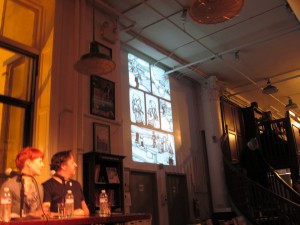
Young’s performance dealt with two major universal themes, family pressures and romantic relationships, but introduced the complicating factor of cultural divides as his character (also named Ethan) engaged in “blunt” conversations with his mother, translated from Cantonese into English, about whether dating a Chinese-American girlfriend was really the right thing for him. Each comics artist preserved a kernel of universal human experience in their works while bringing intricate detail of personal experience into the narrative to render it unique, compelling, and even more visceral. Experiencing the comics as performance, read by their creators, brought an added dimension of reality to the stories. Autobio comics readers often become fans of the “voice” of the cartoonist and feel that they almost know the author/artist personally, but this was a rare chance to hear the comic audibly and experience the comic visually with creator participation.

Christopher Irving took the opportunity to play readers advocate and encourage the panelists to explain how autobiography maps out the gray areas between art and life, asking what the relationship is, exactly, between these creators and their comic avatars. Gulledge explained that her characters are often “different variations” of sides of her personality, and in one of the most memorable phrases from the evening explained that portraying versions of herself in comics encourages her to take risks in expression, making her willing to “drop the baby” being thrown at her if necessary. The allusion was to a situation wherein street urchins might attempt to pick your pocket by throwing a doll at you, pretending it’s a real baby, in the hopes that you’ll be distracted enough to attempt to catch it. “Drop the baby” made for an excellent metaphor for autobiographical cartooning when the creator has to realize the difference between art and real life and take greater risks based on that truth.

Fingerman commented, to the audience’s amusement, that he would “gladly drop a baby”. His reasons for using an avatar named “Rob” rather than his own name, Bob, in MAXIMUM MINUMUM WAGE involved shying away from direct “narcissism” while keeping a certain “weight” of truth alongside the “latitude” for some fictionalization. Like Stephen Colbert’s concept of “truthiness”, he said, his comics get closer to the truth by allowing more freedom of expression than strict autobiography. He also added that after ten years of reflection on MAXIMUM MINIMUM WAGE and working on the new hardcover edition from Image , however, he’s “seriously thinking of coming back to the series and starting it up again”, which provoked a round of enthusiastic applause from the audience.
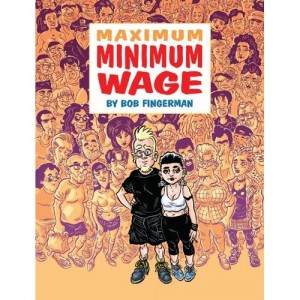
Haspiel’s own feelings about the difference between autobiographical and semi-autobiographical comics, two genres he has worked with extensively, pivot on his concern that autobiographical comics only allow the reader to act as “voyeur” in someone else’s life. Like Fingerman, Haspiel reflected on the fact that semi-autobiographical narratives enable the creator to zero-in on “emotional truths” that they might not be able to emphasize as fully when sticking purely to facts. His advice to autobiographical or semi-autobiographical cartoonists, generally, is to “get outside” and experience life, making sure you “show up to the party” that is life and take part in order to create compelling stories. Gulledge chimed in that she agreed with Haspiel and Fingerman, that even autobiographical comics are not about the cartoonists life in terms of their purpose, but are about “helping” the reader understand themselves by engaging with real-life situations.
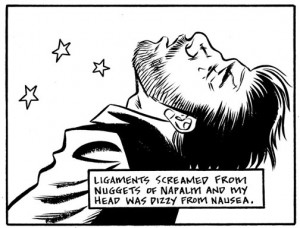
[Image from STREETCODE's "Dumbo" by Haspiel]
Young explained that he feels that his life can, in some ways, seem stereotypical, including his Asian-American heritage, emphasis on city narratives, his real-life situation of quitting college, and even being “self-indulgent” in writing stories designed to “get even” with an ex-girlfriend. But having a relatable life is certainly not a hindrance in autobiographical comics, especially when you capture the “romance” you see in the ordinary. Young hopes to “capture” some truths from his life in a memorable way, such as “living really broke” and “being single in New York”, experiences many readers might share. The most problematic thing Young has faced, he said, about working in autobiographical comics, is that readers equate the Ethan of his comics with Ethan in real life and feel free to tell him that he’s an “asshole” on a regular basis. He’s also been questioned for bringing “fantastic elements” into his works despite their overtly “realistic” tone, and like Haspiel and Fingerman, Young thinks a “metaphorical” element helps him “comment on how interconnected we are with our creations”. It seemed part and parcel of artistic freedom to branch from autobiography into metaphor for several of the panelists.

The discussion between comics artists on the panel was often freeform and interactive during the event, and they chatted about the increasing role of images online, the freedom the internet offers in terms of self-publication, and the impact that it has had on autobiographical comic production. Haspiel commented on the ways that social media has become a form of autobiographical expression, leading him further down the road of embracing metaphor rather than strict biography in his work. Even Gulledge expressed her movement toward “boiling down” life experiences to get to what life is “really about” due to the comparison between unedited and immediate self-expression on social platforms. Haspiel also noted, however, that social media opens up publicity options for web-based work, as in the case of ACTIVATEcomix, which he founded in 2006, and his currently curated multimedia arts site TRIP CITY. The very same technology that raises questions about autobiography by presenting human experience in an unfiltered way can serve as the platform for promoting the more focused works of art that reflect on life’s truths. One of the final topics of the evening focused on advice for cartoonists about funding and publishing their autobiographical and semi-autobiographical works. Now, more than ever, Haspiel argued for the need to be “be part of a community”, whether seeking crowd-funding or readership.
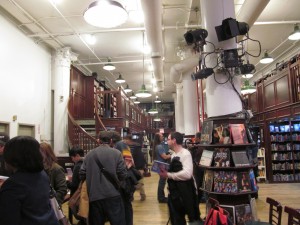
It was clear from hearing the panelists in discussion that they do form their own community of creators supporting many of the same goals in comics, and that each of them has a specific commitment to their readership in creating their work. The fact that the event spotlighting “the cartoonist in comics” not only benefited the comics community by exploring the role of biography and providing insights into creative process, but also raised funds for a worthy local charity emphasized the reciprocal role of community in supporting artwork about the significant truths hidden in everyday life and improving “real life” for those in need. The event was live-streamed by Housing Works and may be available in video format soon.

Hannah Means-Shannon writes and blogs about comics for TRIP CITY and Sequart.org and is currently working on books about Neil Gaiman and Alan Moore for Sequart. She is @hannahmenzies on Twitter and hannahmenziesblog on WordPress.

By:
Heidi MacDonald,
on 12/4/2012
Blog:
PW -The Beat
(
Login to Add to MyJacketFlap)
JacketFlap tags:
News,
Interviews,
Comics,
Indies,
Dean Haspiel,
Kickstarter,
Top News,
Chris Miskiewicz,
seth kushner,
Angry Bob,
Anica Archip,
Black Coffee Blues Band,
Brooke Van Poppelen,
Denver Butson,
Hamilton Gallery Theater,
Jeffrey Burandt,
Jen Fergus,
John Pinamonti,
Luna Sisters,
Smokey Hormel,
Sunny's Bar,
Trip City,
Two Beards One Heart,
Add a tag
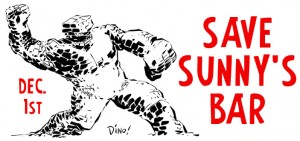
On Saturday, December 1st, the Hamilton Gallery Theater in Caroll Gardens, Brooklyn, hosted a benefit for a Red Hook landmark, Sunny’s Bar, in attempt to help bring it back from the verge of storm-ravaged closure. Sunny’s Bar, only a short distance from the waterfront, was filled with water and sludge by Hurricane Sandy, and its electrical systems, particularly, obliterated. The destruction of Sunny’s hit Brooklyn hard, a punch right in the heart of the artistic community specifically. For many, this was a retreat and a gathering place where memories were made for decades, and, thankfully, they weren’t prepared to let Sunny’s go down without a fight. Marketing, Public Relations, and Event Management professional Anica Archip , and her brother Dmitri Archip, spear-headed the benefit to complement the Sunny’s Kickstarter campaign, still underway, and provided the Hamilton event space. Local businesses donated refreshments, and a devoted arts community supplied over 5 hours of performance in honor of Sunny’s. Emmy-award winning comics artist and arts curator Dean Haspiel rounded up the talent and helped spread the word via social media while Sunny’s staff supported the event through set-up and bartending.
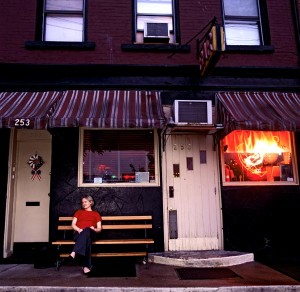
100% of the proceeds went to helping one of the most remote, and most beloved hangouts in Brooklyn back onto its feet. What started out as a small event elicited an overwhelming turnout to the point of rotating crowds off of the event floor to get as many people past the donations table as possible as performances ranged from readings of screen projected comics, poetry, and prose, to comedy performances, and lastly a few hours of wide-ranging musical sets by volunteers. The atmosphere was highly charged, emotional, but also celebratory throughout the night as community support for the benefit became more and more evident. In effect, it became a relocation of Sunny’s own events nights, a home away from home, prefiguring a return to its mecca status in days to come.

A number of the comics and prose performers hailed from Brooklyn’s own digital literary arts salon TRIP CITY, including co-curators Dean Haspiel, Seth Kushner, Chris Miskiewicz, and Jeffrey Burandt, joined by TRIP CITY member Jen Ferguson, and Brooklyn poet Denver Butson. Haspiel performed a comics meditation on Brooklyn and Manhattan during a time of crisis, Beef with Tomato, while also previewing a new creator-owned comic appropriately titled RED HOOK. Photographer and writer Kushner presented an event-inspired essay “My Brooklyn” with slides from his photo book Brooklynites, while writer Miskiewicz provided a haunting narrative set at the bar itself, “Last Night at Sunny’s”. Ferguson, an artist, narrated a CulturePOP photocomic featuring her own Brooklyn Bridge artwork, and writer and musician Burandt presented a recent Brooklyn-set comic “Bibbin’s Bodega” to the accompaniment of a mellow bass-line. Butson proved that poetry could hold its own as performance art with startling observations about the secret emotional and imaginative lives of ordinary citizens. The thematic pieces were well chosen, highlighting the role of community and geography as inspiration for creative work.
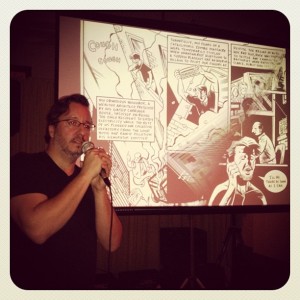
The comedy performances of the evening were raucous and added to the positive vibe building up during the benefit, turning the fund-raiser into an affirmation rather than a reflection on the devastating effects of the hurricane. Brooke Van Poppelen brought a Brooklyn perspective to the vagaries of working in Manhattan and commented on the increasing gentrification of Brooklyn itself, subtly asserting that enduring “real” Brooklyn culture continues in the face of change. Angry Bob came out from Queens to punch holes in the political climate of the recent elections and present the all-too human reactions to hurricane damage including outrage over cable outages in less affected areas. Meanwhile, donated beer on tap was flowing, along with wine, and the crowd situation on the floor was becoming intense. Between performance blocks rotation provided access to Sunny’s supporters.

The musical portion of the evening showcased an astonishing breadth of local talent, including the newly formed band Two Beards: One Heart with lead-singer Jeffrey Burandt debuting new material, John Pinamonti, The Black Coffee Blues Band, and Smokey Hormel supporting The Luna Sisters, many of whom perform as regular bands at Sunny’s on its own event nights. While blues music was particularly appropriate, The Luna Sisters, including Sunny’s proprietor Tone Johansen, really stole the show with their nostalgic and hypnotic performance of classics like “It’s a Wonderful World” and “Bye, Bye Blues”. “Yes, even after Sandy”, Tone declared, “it’s a wonderful world”. Proprietor Sunny himself too the mic to conclude the event, offering his heartfelt thanks and astonishment at the monumental support demonstrated for Sunny’s Bar. Appearing weathered, wearing waterproof clothes, he was nevertheless unbowed by the natural disaster that had struck at his life’s work. It was clear no one really wanted to go home, having missed gatherings at Sunny’s since the storm, but the owners vowed that next time the party would be “at home” when Sunny’s doors, aided by a big push from its denizens, opened again.

The evening came off without a hitch, and the funds raised were the best possible scenario for what started as an ambitious exercise in elbow grease. Anica Archip and Dean Haspiel agreed to tell me a little bit about what Sunny’s means to them and why they poured so much of their time and creativity into making the benefit happen. Archip and Haspiel, like many, have their own deeply personal memories of the beloved bar.
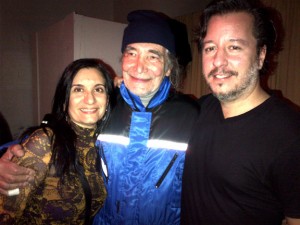
Anica Archip: I’m a Brooklyn, Cobble Hill/Carroll Gardens neighborhood native, Red Hook, Gowanus, and Brooklyn Heights was part of my playground. I remember the first time I set foot in Sunny’s Bar, it was a late summer afternoon around 1994. My car was towed from my street in Carroll Gardens and the lot where the city kept towed vehicles was located directly across the street from Sunny’s. My husband and I (I was married then ) were picking up the car and we were laughing over the whole incident because the day prior we were searching hours for the car convinced that we forgot where it was parked, versus the reality that it was towed. Anyway, as we exited the lot the door to Sunny’s Bar was open and we walked in for a drink. The bar was empty yet magical. The bright setting sun poured in through the window and once my eyes adjusted to the room, I realized we entered a realm frozen in time, a waterfront bar scene from the 1950′s. Behind the counter was a gentle faced man with long hair who looked like he stepped out of 1968, it was Sunny. We sat at the counter, told him of our car adventure and began to chat. I mentioned that my brother tends bar on Atlantic Ave, and just at that moment Sunny looked into my eyes, cupped my face with his large hands and said in his sweet tone, “I know who you are, you’re Dimitri’s sister.” Sunny’s Bar was instantly “home” – a place of comfort, where I could relax and I knew belonged. Needless to say I’ve been going back since.
In 1995 I became an active member of the Brooklyn arts organization BWAC (Brooklyn Waterfront Artists’ Coalition). Their yearly art show was held in the warehouses on the piers of Red Hook around the corner from Sunny’s. We would hang out at Sunny’s on Friday nights (the only night it was open back then) and listen to live music, it was impromptu not planned; talk with the neighborhood old timers; drink some Pabst or Schlitz beer, and just hang into the wee hours of the morning. You never arrived before 10pm, it became packed with artists, musicians, writers, dancers, and local neighbors by midnight and then closed about an hour or so before sunrise. And Sunny was always there to greet you with a big warm hug. Sunny’s hugs are special, just about everyone wants to be hugged by Sunny. It’s even listed as one of the items people can receive if they pledge a donation on the “Bring Sunny’s Back Home!” Kickstarter site:
Dean Haspiel: When I first moved to Brooklyn in 1997, I heard whispers about an old bar in Red Hook that hadn’t aged. When I first entered Sunny’s, it was like stepping into the past. An era I never lived in but always wanted to visit. And, it was one block away from the sea. It was the first bar I ever went to where the goblins in my head were quelled by the folk art and bluegrass music. I would just melt into the background for hours. It was a destination spot for people who wanted to get away and raise their glass to the Statue of Liberty and toast to an era of New York City that artists and blue collar workers could afford and pontificate a week of hard work.
Sunny himself would often appear like a specter of levity and brighten the room with his long hair and infectious smile. I got friendly with the bartenders and eventually met Tone, Sunny’s wife, who sings songs and curates the art shows in the back of the bar where musicians assemble and play music. I remember when Michael C. Maronna, star of the 1990′s kids TV show THE ADVENTURES OF PETE & PETE, would tend bar. Sunny’s is where my pal, Jonathan Ames, introduced me to actor/song writer, Jason Schwartzman, right before we started shooting HBO’s “Bored To Death.” In fact, a scene from “Bored To Death” was shot at Sunny’s. These days, I’ll occasionally bump into actor Michael Shannon and trade late night quips. But, more importantly, Sunny’s draws people who are worth their salt because it’s not easy to get to. Sunny’s is the last bar at the end of the world and when the apocalypse happens, that’s where you’ll find me.
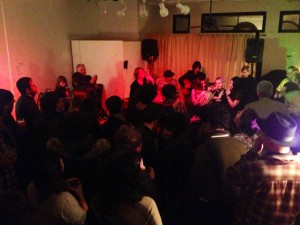
Haspiel and Archip also commented on the strange genesis of the idea for the event, which easily might have fallen by the wayside as Brooklyn, and the rest of the East Coast pushes to rebuild the essentials as quickly as possible.
AA: A small group (4 people + 1 cat) of Red Hook artist friends took refuge at my house when they had to evacuate due to the arrival of Hurricane Sandy. The morning after the superstorm hit we walked over to Red Hook to check out the damage and check in on other friends. What we saw was unexpected and shocking. My childhood friend’s home was severely damaged, people were coming out into the streets in tears, huge trees were ripped off their roots and power lines were left dangling. The streets were slicked with a coating of oil from boilers that were damaged and destroyed. The air was thick with the smells of oil and gas from spills that now settled in the streets of Red Hook. Block after block looked like aftermath of a war. I knew I had to check in on Sunny’s because they’re located at the very edge, just where the water meets the land. When I arrived Tone was standing outside with a look of horror in her eyes, tears started to flow from her face. We immediately embraced and she muttered, “Water is still rushing into the basement, the water is still coming in, I can’t stop the water.” A few people now gathered in front trying to help her and I overheard someone say that the water main pipe that connects to the building broke. They needed to shut off the city line from the sidewalk. An emergency vehicle, I think it was a utility company, pulled up in front of the bar and Tone ran to tell them of the problem. As I walked back home in silence my mind was racing with all I had witnessed and I felt helpless.
Dean & I had touched base in the days after Sandy and we briefly talked about what we saw and the damage to our beloved Sunny’s Bar. I then received an email from Dean about his idea to help Save Sunny’s, he asked if I was interested in helping and I knew that I could execute his vision. I immediately said Yes! And then approached my brother about having the benefit in our home.
A side bar note here is that Dean & I would occasionally meet up at Sunny’s throughout the years – we still do. In the early 2000′s after hangin’ at the Smith Street bars, on a Friday night, we’d sometimes do the Red Hook scene - which was Lilly’s Bar (now closed) and of course Sunny’s. You always ended the night at Sunny’s. Dean would ride over on his bike and I’d either walk it or take a car service. Attached is a b&w photo circa 2004(?) taken by my photographer friend Judy Parker (who was visiting from the Bay Area with her sister) of a Friday night walk along Beard street from Lillie’s to Sunny’s. Pictured is me, Dean’s bike and his cast shadow – sometime after 1am. I don’t think Dean’s ever seen this.
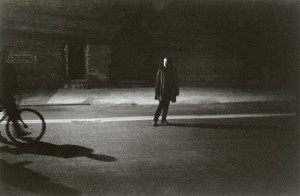
DH: A couple of days after Superstorm Sandy annihilated New Jersey and ravaged NYC, I rode my bike over to Red Hook and saw everyone’s destroyed basements on the sidewalks. When I finally got to Sunny’s, I saw the staff pumping water and made eyes with Tone. Sunny’s basement was a box of sludge, the boiler was busted and the electricity panels were destroyed among other flood damage to the bar. And, to make matters worse, the foundation was compromised. I knew right then and there that I had to do something. As Brooklyn began to rally relief, I made it my mission to help out the place I call home on the Friday and Saturday nights I unchain myself from my desk. I contacted my pal/publicist/event manager/and longtime friend of Sunny’s Bar, Anica Archip, to ask if she would manage and host an event [along with her brother Dimitri] to help promote and raise funds for Sunny’s. Anica immediately said “yes” and we approached Tone who said “yes,” offering to staff the night with the actual staff from Sunny’s. We co-curated the event and I designed a poster with Seth Kushner but it was Anica who truly handled all the nuts and bolts. Along with select TRIP CITY curators and contributors reading prose and comix (Jeffrey Burandt, Chris Miskiewicz, Jen Ferguson, Zees Moreno), local bands, poets, and comedians (Denver Butson, Brooke Van Poppelen, Angry Bob, Black Coffee Blues Band, Smokey & The Luna Sisters), we created a stellar evening that would bring people and diehard Sunny’s patrons together for a donation based evening where we provided entertainment and drinks. Jeffrey Burandt debuted his new band, Two Beards One Heart, and I debuted my new comic, The Red Hook. We gave them a little bit of Trip City to nosh on while recreating a night at Sunny’s. It was glorious.

Following the event, Archip and Haspiel reflected on the highlights of the evening that meant the most to them and made it all worthwhile.
AA: This one’s easy. Seeing the happy faces of Sunny’s clientele – his family of friends - my friends. A month had passed since Sandy hit and everyday in Red Hook has been devoted to the clean up. Pumping water, throwing out damaged personal items, family treasures, furniture, vital equipment, parts of your house, applying for help, filing papers. Sleep, rinse, repeat. But on this one night friends gathered, took a break, met up as they normally would at Sunny’s. They enjoyed the entertainment, had a beer or two, were greeted by a smiling, happy Tone, chatted with their favorite bartender and got their hug from Sunny. Helping to reunite this community of friends was worth it all.
DH: Besides witnessing all the support for Sunny’s, I think my favorite parts of the night were hearing Tone sing with her wonderful Luna Sisters and seeing Sunny end the evening with his gracious praise and infectious smile. He reminded us that this wasn’t for Sunny’s Bar but for us. All of us. Sunny’s Bar isn’t just another ancient watering hole. It’s an everlasting community.
Hannah Means-Shannon writes and blogs about comics for TRIP CITY and Sequart.org and is currently working on books about Neil Gaiman and Alan Moore for Sequart. She is @hannahmenzies on Twitter and hannahmenziesblog on WordPress.




















































Beautifully written! This manages to capture how truly amazing the evening of performances was. Hope there are more salons like this one!